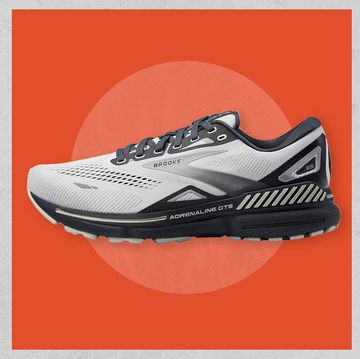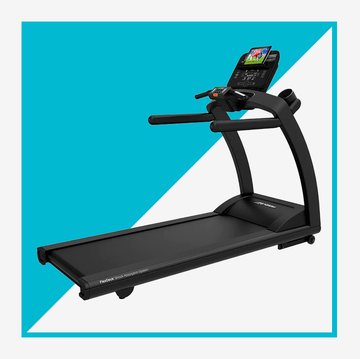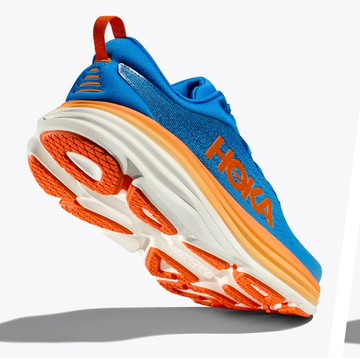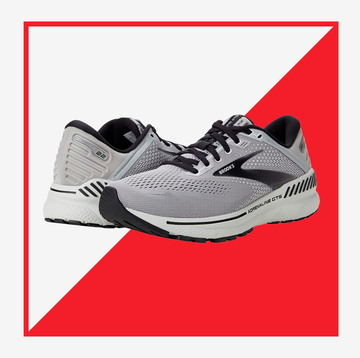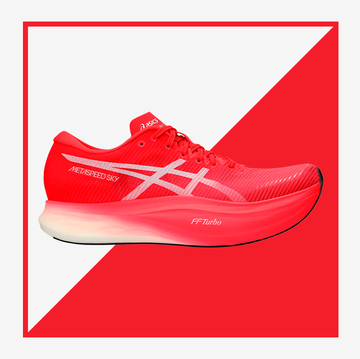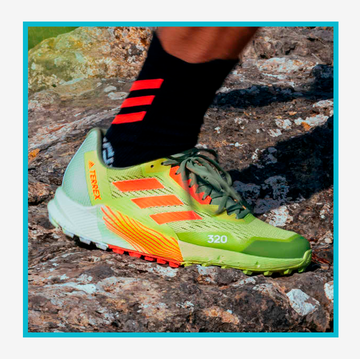If you take the right preventative measures, you can avoid pain before it starts. The American College of Sports Medicine recently released the 5 most common injuries runners face every year. Here are some of the best ways to avoid the most-frequent pains, strains, and aches that can come with the territory.
1) Hamstring Muscle Strain
The Problem: The back of your thigh stiffens or feels knotted, especially when accelerating or decelerating. One of your three hamstring muscles that allow you to bend your knee—the semitendinosus, semimembranosus, or biceps femoris—has either stretched too far or torn. This can happen when your hammies are challenged with a sudden load: for runners, this happens when you break into a sprint and ask your muscles for the force needed to accelerate your body's weight.
Thwart It: Try a hamstring-strengthening exercise like the Swiss ball hip raise and leg curl. Lie on your back with your heels on a Swiss ball. Lift your hips so your body is straight from ankles to shoulders. Pull the ball toward your butt as you bend your knees. Reverse the move, but don’t let your hips sag or touch the floor. Do 2 to 3 sets of 8 to 12 reps.
2) Iliotibial Band Syndrome
The Problem: You feel pain on the outside of your knee. Your IT band, the tissue on the outside of your thigh that stabilizes your knees and hips, is rubbing part of your lateral femoral condyle, the projecting part of your thigh bone. The most likely culprits are excessive down- or uphill running, bow-legged movements, a long stride, weak hips, or incorrect foot-to-ground contact.
Thwart It: Strengthen your hip abductors with an exercise recommended by Reed Ferber, Ph.D., director of the Running Injury Clinic. Anchor one end of a resistance band to the leg of a stable bench. Stand with your feet parallel to the bench and attach the other end of the band to your outside foot. Now pull the band away from the bench with your outside foot and hold for 2 seconds, and then release for 2. (You can view a video demonstration here.) Start with one set of 10 reps for each leg and increase to 3 sets over time. You can also work on your stride by following this guide.
3) Ankle Sprain
The Problem: You twist, roll, or turn your foot unevenly and the ankle ligaments stretch beyond their normal range. According to the American Academy of Orthopaedic Surgeons, approximately 25,000 people sprain their ankles every day. If you have slight swelling and feel pain if you jog or jump, your ankle will typically heal in one to two weeks, says Jonathan Cluett, M.D., an orthopedic surgeon in Massachusetts. If you see bruising or can’t walk, expect at least three months to feel back to normal, Cluett says.
Thwart It: If you’ve sprained your ankle before, it’s much more likely that you will do it again—and it will hurt more. Use an ankle brace and tape after injuring it and you are 35 percent less likely to do it again compared to those who did nothing, says a Wellesley College study. “For a brace to be effective, it often restricts motion that is normal while performing a sport,” Cluett says. For a supportive brace, check out a lace-up model, says Cluett, like the Lace-Up Ankle Brace Splint ($36.97, nationalbraceandsplint.com). If you’re looking for a bit more flexibility, look at the ProCare Neoprene Ankle Sleeve (21.99, braceshop.com).
4) Stress Fractures
The Problem: Your muscles become tired and can’t absorb added shock due to overuse. The fatigued muscle eventually transfers the stress to your bone, causing a tiny crack. More than half of all stress fractures occur in the lower leg, according to the American Academy of Orthopaedic Surgeons. The most common spot to injure is your tibia, or shinbone, but the bones in your feet, fibula, femur, and pelvis are also at risk.
Thwart It: A study in American Family Physician showed that taking calcium and vitamin D supplements lowers your chances of a stress fracture. Also, if starting a new training program, begin at a low mileage and gradually increase the amount you run each week, says sports medicine professionals David Tietze, M.D. and Thomas Best, M.D. Increase your mileage no more than 10 to 20 percent per week.
5) Runner’s Knee
The Problem: You feel a dull ache under the center of your knee that feels worse after walking uphill. This patellofemoral pain syndrome, or runner’s knee, occurs when your thigh bone rotates too far inward, which leads to pressure on your kneecap.
Thwart It: Strengthen your hip muscles by doing the hip abductor exercise described to prevent iliotibial band syndrome. You can also move your banded leg behind you 45 degrees for 2 seconds and release for 2 seconds, working your gluteus medius, the muscle that internally rotates your hip.

